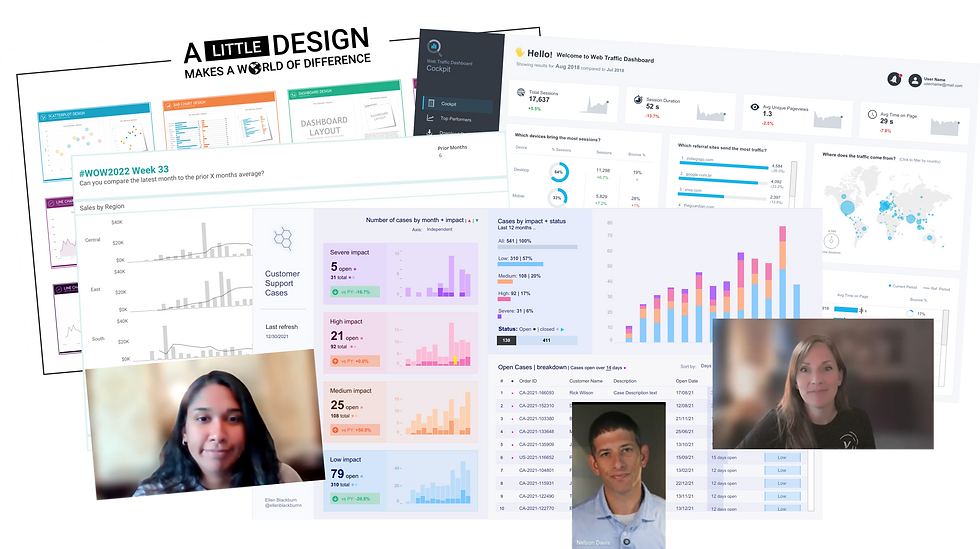Data Visualization: Transforming Raw Data into Insightful Stories with Tableau
- Jennifer Dawes

- Aug 5, 2024
- 4 min read
Updated: Jan 2

Introduction
As someone who started my career in Human Resources, I never imagined data visualization would become such a pivotal part of my journey. My discovery of Tableau was a game-changer—one that opened my eyes to the power of data to influence change. In this article, I want to share my passion for data visualization and how Tableau can help anyone transform raw data into compelling stories that drive meaningful decisions.
The Importance of Data Visualization
Data visualization isn't just about making numbers look pretty on a screen; it's about storytelling. It's about taking complex datasets and turning them into visuals that inform and inspire action. From my experience in HR, I learned that clear, insightful visuals could break down silos, foster understanding, and drive strategic initiatives. Here's why data visualization is so important:
Enhancing Understanding: Visuals simplify data, making it accessible to everyone, regardless of their technical expertise. For example, in HR, a well-crafted visualization can quickly reveal patterns in employee engagement or highlight areas for improvement in diversity and inclusion.
Facilitating Decision-Making: When you're dealing with large volumes of data, it can be overwhelming. Visualization tools like Tableau can distill this information into key insights, helping leaders confidently make informed decisions.
Communicating Findings: I've found that a good visualization can speak louder than a thousand words. In meetings, dashboards and charts can effectively communicate complex ideas, ensuring that everyone understands the narrative behind the data. This clarity can unite teams and align efforts towards common goals.
Engaging and Persuasive: In my career, I've seen how powerful visuals can engage an audience and persuade them to act. Whether it's advocating for a new employee wellness program or showcasing the success of a recent initiative, data visualization makes the message more compelling.
Why Tableau?
Tableau became my go-to tool for data visualization, and here's why it could be yours too:
User-Friendly Interface: Tableau's drag-and-drop functionality makes it easy to create stunning visuals without needing advanced technical skills. I remember being amazed at how quickly I could build a comprehensive dashboard that told the story of our department's progress.
Integration Capabilities: One of the things I love about Tableau is its ability to connect with various data sources. Whether it's Excel spreadsheets, cloud services, or databases, Tableau brings it all together. This flexibility allowed me to combine HR metrics with financial data, offering a holistic view of our operations.
Advanced Analytics: Tableau's analytical features go beyond simple charts. With trend analysis and forecasting, I could predict future staffing needs and budget accordingly. This proactive approach was invaluable in strategic planning sessions.
Interactive Dashboards: Tableau's interactive dashboards are a game-changer. They let users explore data, filter by different criteria, and drill down into specifics. This interactivity made it easy for my colleagues to find the information they needed, fostering a culture of data-driven decision-making.
Scalability and Collaboration: Whether you're a team of one or a global enterprise, Tableau scales to meet your needs. The collaborative features allow teams to share insights and work together on data projects, making it an integral part of any organization's toolkit.
Best Practices for Using Tableau
Based on my experience, here are some best practices to get the most out of Tableau:
Know Your Audience: Tailor your visuals to your audience's needs and preferences. In HR, I found that executives preferred high-level summaries, while managers needed more detailed breakdowns.
Focus on Clarity: Keep your designs simple and clean. It's tempting to add lots of bells and whistles, but clarity should always come first. Make sure your visuals highlight the most important information.
Use Color Wisely: Color can make or break a visualization. Use it to draw attention to key data points, but avoid overwhelming your audience with too many colors. Consistency is key.
Maintain Data Accuracy: Trust in your data is crucial. Always double-check your sources and calculations to ensure the accuracy of your visualizations. Mistakes can erode trust and lead to poor decision-making.
Iterate and Improve: The first draft of a visualization is rarely perfect. Gather feedback and continuously refine your work. As new data becomes available, update your dashboards to keep them relevant and accurate.
Tell a Story: Every visualization should tell a story. Start with a clear objective and build your visualization around it. Use titles, captions, and annotations to guide your audience through the narrative and emphasize the key takeaways.
Conclusion
Data visualization has been a transformative tool in my career, and Tableau has been at the heart of that journey. It's more than just software; it's a means to empower, inform, and inspire. Whether you're an HR professional, a data analyst, or a business leader, Tableau can help you unlock the full potential of your data and turn it into actionable insights.
In a world overflowing with data, the ability to visualize it effectively is invaluable. So, dive into the world of Tableau and start telling your own data stories—who knows where it might take you!






Comments